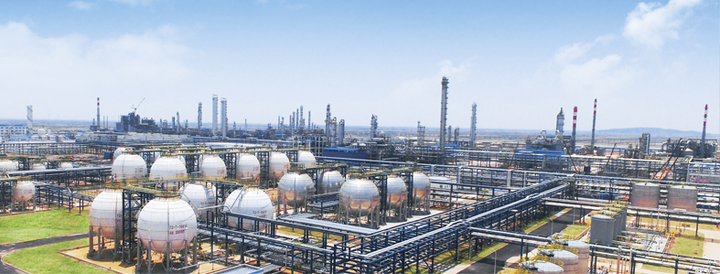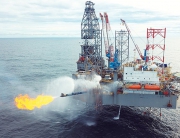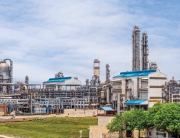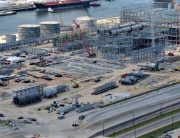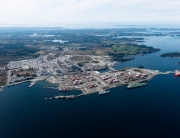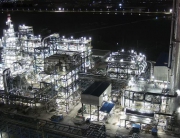Shenghong Refining & Chemical (Lianyungang) Co. Ltd. (SRCLC), a subsidiary of Shenghong Petrochemical Group Co. Ltd., has let a contract to KBR Inc. to supply catalyst for a vinyl acetate monomer (VAM) project at its planned 16-million tonnes/year integrated refining complex in Lianyungang City in China’s province of Jiangsu.
As part of the contract, KBR will provide proprietary catalyst for SRCLC’s grassroots 300,000-tonnes/year unit, which will include the first commercial application of Showa Denko K.K. (SDK) of Japan’s proprietary VAM technology under a licensing agreement between KBR and SDK, KBR said.
The service provider neither disclosed a value of the SRCLC VAM contract nor revealed further details regarding the project.
This latest contract for the VAM project follows SRCLC’s previous award to KBR to deliver licensing and basic engineering design for the proposed SDK-based VAM unit, according to a Nov. 18, 2019, release from KBR.
SRCLC’s complex overview
While Shenghong Petrochemical has released few details directly regarding SRCLC’s proposed integrated complex—including any definitive timeframe for its commissioning, which previously was due for startup in 2019—the Ministry of Ecology and Environment of the People’s Republic of China (MEE) provided an overview of the planned development in its “Reply on the Environmental Impact [Assessment] (EIA) Report of Shenghong Refining & Chemical (Lianyungang) Co. Ltd.’s Refining & Chemical Integration Project” issued on Dec. 12, 2018.
To be located at Lianyungang Petrochemical Industrial Base in Xuwei New District, Lianyungang City, the proposed integrated complex will process imported crude oil for production of China VI-quality fuels, as well as produce 2.8 million tpy of aromatics and 1.1 million tpy of ethylene.
Alongside its combined 16-million tpy atmospheric-vacuum distillation unit, the complex will include the following unit capacities:
- Light hydrocarbon recovery, 4 million tpy.
- Kerosine hydrogenation, 1.8 million tpy.
- Delayed coking, 2 million tpy.
- Hydrocracking (Unit 1), 3.5 million tpy.
- Hydrocracking (Unit 2), 3.6 million tpy.
- Residue hydrogenation, 3.3 million tpy.
- Gasoline-diesel hydrogenation, 3 million tpy.
- Sulfur recovery, 600,000 tpy.
- Continuous reforming (two units), 3.2 million tpy each.
- Paraxylene production, 2.8 million tpy.
- Ethylene production, 1.1 million tpy.
- Acrylonitrile production, 260,000 tpy.
- Methyl methacrylate production, 90,000 tpy.
- Ethylene vinyl acetate production, 300,000 tpy.
Alongside its own integrated gasification combined-cycle power generation plant as well as 27 sets of other unidentified equipment, the complex also will include a terminal port in the Xuwei Port area of Lianyungang Port, which will include a 300,000-tonnes crude oil berth and four 50,000-tonne liquid chemical berths, according to MEE.
While MEE lauded the proposed project for its ability to help meet domestic demand for cleaner products, as well as its potential to promote future development of the regional petrochemicals industry, the ministry determined the project’s overall scope of construction and operation would negatively impact the region’s environmental health. As a result, MEE stipulated the project—to move forward—must strictly implement various ecological environmental protection measures, as well as adopt the most stringent environmental risk prevention measures, environmental management systems, environmental monitoring methods, and emergency measures.
Based on a search of information available to the public, Shenghong Petrochemical has yet to disclose a formal reply or revision of the project’s EIA in response to MEE’s December pronouncement.
Shenghong Petrochemical’s existing subsidiary operations at the integrated Lianyungang City complex include a 1.5-million tpy purified terephthalic acid project and a completed nearly 1-million cu m liquid chemical warehousing project. Three berths at the site’s liquid chemical terminal also have been completed, according to the operator’s website.
Subsidiary Jiangsu Sailboat Petrochemical Co. Ltd. also has partially entered a 3.6-million tpy methanol polygeneration unit into production, which uses a methanol-to-olefins process to produce downstream derivatives such as ethylene vinyl acetate copolymer, ethylene oxide, acrylonitrile, and methyl methacrylate, among others, according to Shenghong Petrochemical’s website.
Source: www.ogj.com


